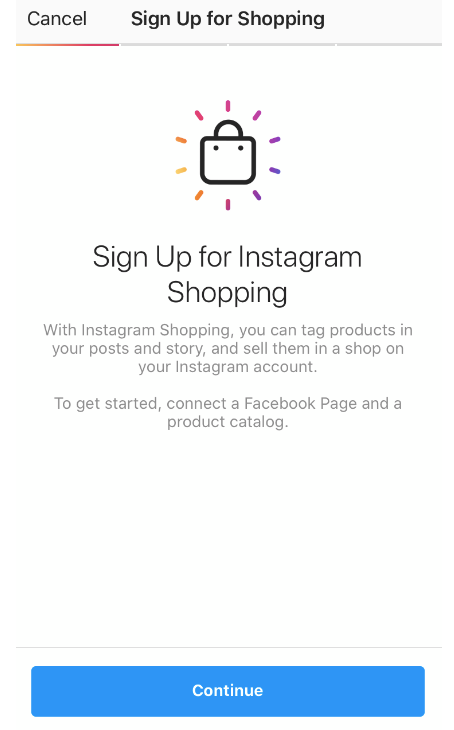If you sell products online, you should be using Instagram shopping.
Rather than directing customers from your Instagram account to your website, Instagram shopping allows them to select and purchase products easily from the app.
With more than 1 billion monthly users, your customers are already on Instagram. Make it easy for them to discover and shop your brand with Instagram shoppable posts!
In this post, you’ll learn:
- Why you should be using Instagram shopping
- How to set up Instagram shopping posts and Stories
- How to optimize your shoppable posts to drive sales and engagement
Bonus: Download a free checklist that reveals the exact steps a lifestyle photographer used to grow from 0 to 600,000 followers on Instagram with no budget and no expensive gear.
Why use Instagram shopping posts?
Instagram is an essential platform for retail brands, with 200 million Instagram users visiting at least one business profile every day.
In the past, you could use Instagram to build your audience and connect with your fans, encouraging them to visit your website or brick-and-mortar shop. But since 2017, Instagram shopping has allowed brands to transform their profiles into virtual storefronts. Users can shop like Ariana Grande— see it, like it, want it, got it— in one seamless transaction.
The opportunities are huge: 70% of shopping enthusiasts use Instagram for product discovery, and more than 130 million users click on a shopping post at least once per month.
With just a few simple steps, you can set up Instagram Shopping to unlock an easy, enjoyable shopping experience for your customers.
Let’s get started!
How to set up Instagram shopping posts
Getting started with Instagram shopping requires a little legwork, but you can be up and running within a few days! Use our simple checklist below.
Step. 1: Check that you meet the requirements
Before you can set up Instagram Shopping, you need to ensure your business meets three criteria.
Step 2: Create your product catalog on Facebook
Once you’ve added your products to the catalog, you’ll be able to tag them in your Instagram posts and Stories. You can also set up a shop on your Facebook Page.
Tip: When adding product names, make sure they’re descriptive so users can tell what item in the photo has been tagged. For instance, “The Khaleesi” doesn’t tell you what product is for sale; “The Khaleesi Leather Vest” is more helpful.
Step 3: Get approved for Instagram shopping
Once you’ve set up your catalog and checked that your business fulfills the requirements, you can submit your account for review.
Go to your Settings, tap Business, and then Sign Up for Instagram Shopping. Follow the steps and hit submit. Review and approval may take a few days.
Step 4: Turn on shopping in the Instagram app
Once you’re approved, you’ll see a new option under Settings and Business, titled Shopping. Tap it to turn on shopping in the Instagram app.
Step 5: Set up your first shoppable Instagram post!
You’re ready to start making sales! First, upload a photo just like you would for a regular post. Then tap the items you want to tag. You can tag up to five products per post.
Start typing the name of the products you want to tag. These must correspond to the names in your product catalog. Select them as they appear in the search box.
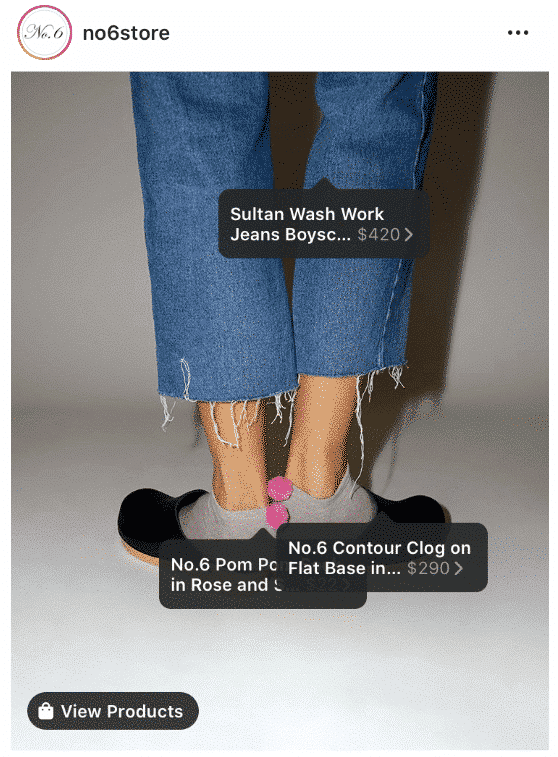
You can also tag up to five products in video posts. A tray will appear where you can select the products.
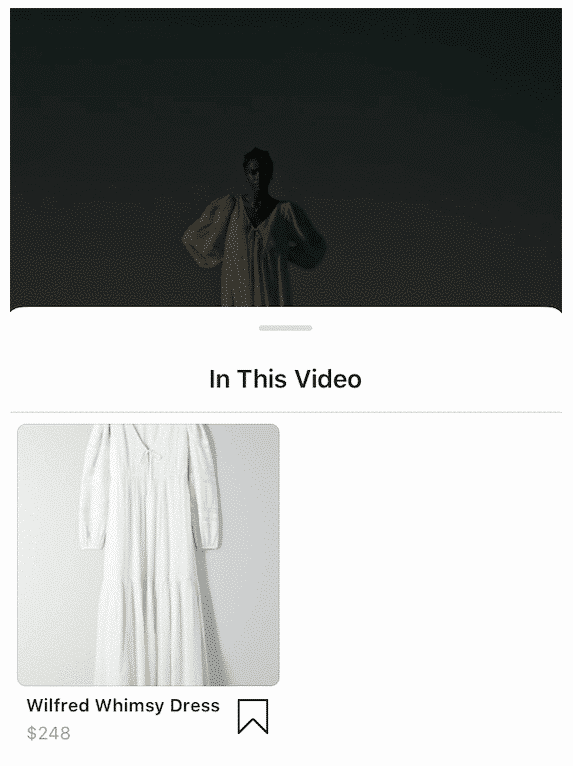
Tips:
- Instagram shoppable posts are identified in your feed by the shopping bag icon in the top-right corner.
- All the products your account has tagged will appear on your profile under the Shopping tab.
How to set up Instagram shopping Stories
More than 500 million users are watching Instagram Stories every day.
Customers can also shop your Stories. You can tag one product per Instagram Story.
Start by uploading your Story. Then tap the sticker icon in the top-right corner, and select Product. From there, select the item from your product catalog.
Tip: You can customize the look of the product sticker to match the colors of in your Story.
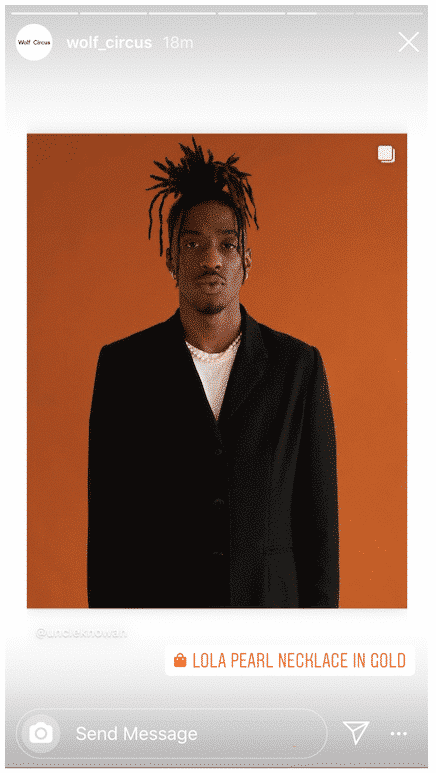
Instagram Checkout
Instagram checkout is just what it sounds like—a feature that enables users to purchase products without leaving the Instagram app.
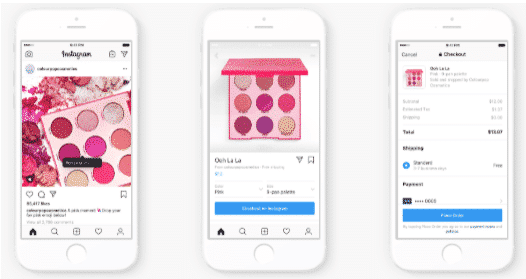
According to Instagram, “Checkout enhances the shopping experience by making the purchase simple, convenient and secure. People no longer have to navigate to the browser when they want to buy. And with their protected payment information in one place, they can shop their favorite brands without needing to log in and enter their information multiple times.”
However, the feature is still in beta in the United States. Twenty-three brands—including Nike, Outdoor Voices, and Zara—are involved in testing before checkout rolls out globally.
As of March 2019, no set-up instructions are available for brands outside this exclusive testing cohort. But brands who are eager to participate would do well to get familiar with either Shopify or BigCommerce—the two e-commerce platforms Instagram is working closely with on checkout. You can also give your two cents on the new feature by filling out this form.
Note: From a functionality and privacy standpoint, Instagram checkout is considered separate from Instagram shopping. On its help page for Instagram checkout, Instagram says, “Only purchases made through Instagram checkout are protected by our Purchase Protection Policies.”
9 tips for selling products with shopping on Instagram
Selling your products on Instagram is simple, but that doesn’t mean it’s effortless. You still need to be thoughtful and creative with your shoppable Instagram posts and Stories.
To help you stand out, we’ve lined up some of our best tips for selling products below:
1. Use striking visuals
No matter how much the platform evolves, the value of striking images and videos on Instagram remains constant. Taking good photos and uploading high-quality videos is key to standing out in the crowd and stopping users from scrolling on by.
Occasionally, Instagram changes up its image and video specifications. Make sure you’re uploading the correct file sizes to ensure your photos look sharp.
Product images should be exciting and editorial, with surprising details that make users want to look closer. A shirt on a hanger ain’t gonna cut it. Try one of these exciting collage tools, or check out some Instagram photo trends for inspiration.
2. Add hashtags
Using relevant Instagram hashtags is a smart strategy for all posts, including shopping content. They increase the discoverability of your content, boosting the engagement on each post.
They can also help you land on the Explore page, which has a special “Shop” tab and is visited by more than 50% of Instagram users each month (that’s more than half a billion people).
A few best practices for hashtags:
- Do your research. Check out the hashtags your competitors are using, and investigate which hashtags are popular in your industry.
- Don’t add hashtag clutter. Just because you can include 30 hashtags on a post, doesn’t mean you should. Nine is the magic number
- Double-check meanings. There are plenty of horror stories from brands that hopped on a trending hashtag bandwagon without doing their homework. (Here’s one NSFW example!) Don’t make the same mistake.
Read more about best practices for Instagram hashtags.
You should be monitoring the hashtags you use on each post. Instagram Analytics will let you see how effective your hashtags are, so you can refine your strategy.
3. Share a sale or promotional code
The power of a good promotion is undeniable. How many of us have mulled over a purchase for months (okay, days) before finally hitting “Purchase” when a perfectly-timed 15% off code appears?
Running a promotional campaign is a surefire way to drive sales. And when you can promote the code directly in your shoppable Instagram posts, it’s even easier for customers to act.
Offering your Instagram customers an exclusive sale is another way to build audience loyalty and increase engagement. For example, Vancouver retailer ARC Apparel launched a “$50 Friday” weekly sale, where users could shop a limited selection of special pieces exclusively through Instagram Stories.
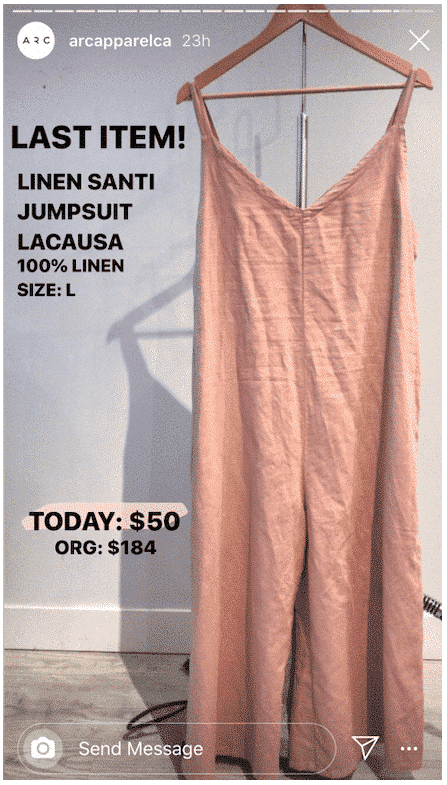
Imagine how much more effective this unique strategy would be if the Stories were shoppable!
4. Show your product in action
The most popular type of video content on Instagram is the tutorial or how-to video. And this format is ideal for shopping posts, because it offers viewers product education and proof-of-concept.
Fenty Beauty regularly shares educational beauty tutorials, with featured products tagged for purchase. They’re compulsively watchable, and they also showcase the quality and versatility of each product.
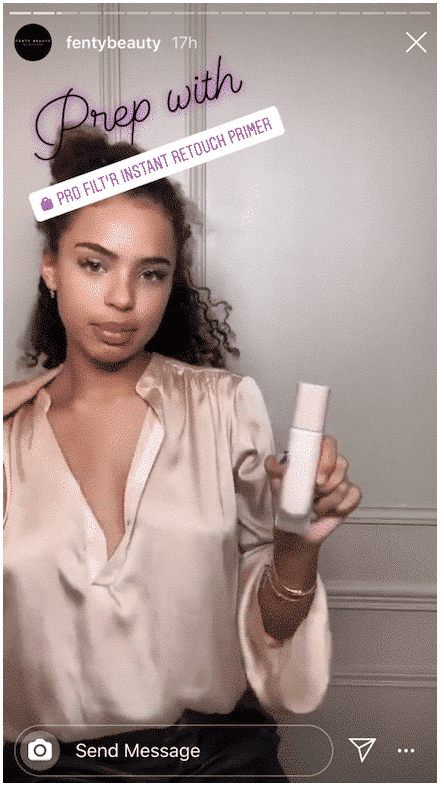
5. Be authentic
When sharing product posts, don’t miss the opportunity to connect with your audience. There’s no need to stick to product copy. Your personality and voice should shine through here.
Pair your photo or video with a thoughtful caption that offers a surprising insight, an interesting fact, or an emotional connection. Talk about how the product was made, or who inspired it.
Many Instagram shoppers care about more than just how a product looks (or how much it costs). Gen Z shoppers in particular want to support businesses that share their values, and resonate with their personal identities.
Learn more about establishing your authentic brand voice.
6. Play with color
If you’ve ever watched a nature documentary, you know that birds use bright plumage to attract a mate. (If you didn’t know that, here you go!) Take a tip from them and make your product shots vibrant and eye-catching.
For a show-stopping post, try shooting against a colorful accent wall like Your Bag of Holding.
Or go monochrome and match shades, like the Saltwater Collective.
7. Establish a signature style
Having a consistent aesthetic on Instagram will help you improve your brand recognition and establish your identity. It also helps customers scrolling through their feed or browsing the Explore tab to recognize your posts at a glance. Plus, it adds up to a very pleasing feed:
Your signature style on Instagram should be consistent with your brand visuals elsewhere. Your website, ads, and product packaging should all fit together, with complementary images.

It can also help you differentiate your brand. Take a look at your competitors and consider how you can stand apart.
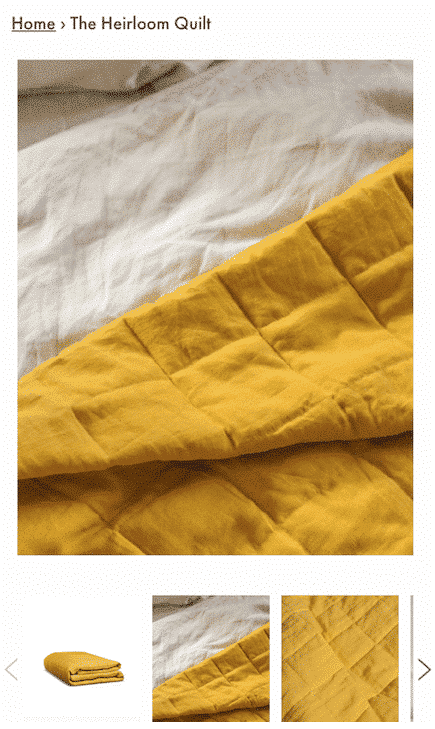
Tips:
- Reinforce your brand identity with your signature palette. Are you refined and muted? Sweet and pastel? Dark and sultry? Bright and energetic? Your style guide can be a helpful tool
- Use the same filter or Instagram presets on all your posts for a consistent look.
- Include at least one of your signature colors in each post.
Learn more about honing your brand’s distinct Instagram aesthetic.
8. Be inclusive
If you want your brand to reach a wide audience, you need to ensure your images are meaningfully representative.
With over a billion users, it’s safe to say that Instagram users are a diverse group. But too often, the people in Instagram promotions and images look the same: white, able-bodied, slim. Only 2% of advertising images feature plus-size women.
And Instagram users who don’t see themselves reflected in that narrow slice of humanity are understandably fed up. Boring brand images aren’t just a failure of imagination; they’re also bad for business, as customers who feel excluded will take their business elsewhere.
Context matters too. Without even realizing it, we may reproduce stereotypes in advertising, like depicting women in the kitchen and men in the office. Think about the story you’re telling in each photo and what it communicates to your audience.
9. Share user-generated content
User-generated content (UGM) refers to any posts or Stories from Instagram users that feature your products. UGM is a huge asset when it comes to promoting your products!
Not only do these posts provide new, real images of your photos in action, they also boost your credibility. That’s because posts from real users are considered more authentic, and that authenticity translates to higher trust. They’re like visual testimonials. In fact, 79% of survey respondents say UGM influences their purchasing decisions.
If those photos come from high-profile customers, all the better. Lizzo makes me feel many things, but until recently, she had not made me feel an intense longing for a forest-green unitard. That all changed with this post:
Before sharing UGC on your own feed, make sure you’re following best practices for sharing user-generated content:
- Ask permission before reposting
- Tag the original creator
- Ensure the photo fits with your brand aesthetic
Shopping on Instagram is continuing to grow in popularity, and it’s only a matter of time until features like Instagram checkout are everywhere. There’s no time like the present to dive in and find out how much it can benefit your business!
Save time managing your Instagram presence using Hootsuite. From a single dashboard you can schedule and publish photos directly to Instagram, engage the audience, measure performance, and run all your other social media profiles. Try it free today.
